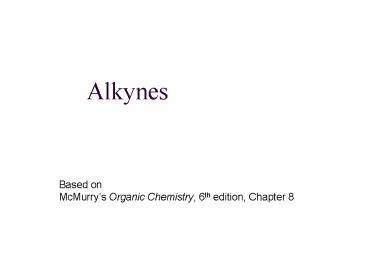Alkynes - PowerPoint PPT Presentation
1 / 22
Title:
Alkynes
Description:
Numbering of chain with triple bond is set so that the ... Keto-enol Tautomerism ... of a proton are called tautomers and the phenomenon is called tautomerism ... – PowerPoint PPT presentation
Number of Views:493
Avg rating:3.0/5.0
Title: Alkynes
1
Alkynes
- Based on
- McMurrys Organic Chemistry, 6th edition, Chapter
8
2
8.2 Naming Alkynes
- Numbering of chain with triple bond is set so
that the smallest number possible include the
triple bond
Indices 3 and 6 are needed
3
Always ene before yne
4
(No Transcript)
5
8.3 Preparation of Alkynes Elimination Reactions
of Dihalides
- Treatment of a 1,2 dihaloalkane with KOH or NaOH
produces a two-fold elimination of HX - Vicinal dihalides are available from addition of
bromine or chlorine to an alkene - Intermediate is a vinyl halide
6
8.4 Reactions of Alkynes Addition of HX and X2
- Addition reactions of alkynes are similar to
those of alkenes - Regiospecificity according to Markovnikov
7
Addition of Bromine and Chlorine
- Initial addition gives trans intermediate
- Product with excess reagent is tetrahalide
8
Addition of HX to Alkynes Involves Vinylic
Carbocations
- Addition of H-X to alkyne should produce a
vinylic carbocation intermediate - We are not sure it does
9
8.5 Hydration of Alkynes
- Addition of H-OH as in alkenes
- Mercury (II) catalyzes Markovinikov oriented
addition - Hydroboration-oxidation gives the non-Markovnikov
product
10
Mercury(II)-Catalyzed Hydration of Alkynes
- Alkynes do not react with aqueous protic acids
- Mercuric ion (as the sulfate) is a Lewis acid
catalyst that promotes addition of water in
Markovnikov orientation - The immediate product is a vinylic alcohol, or
enol, which spontaneously transforms to a ketone
11
Mechanism of Mercury(II)-Catalyzed Hydration of
Alkynes
- Addition of Hg(II) to alkyne gives a vinylic
cation - Water adds and loses a proton
- A proton from aqueous acid replaces Hg(II)
12
Keto-enol Tautomerism
- Isomeric compounds that can rapidily interconvert
by the movement of a proton are called tautomers
and the phenomenon is called tautomerism - Enols rearrange to the isomeric ketone by the
rapid transfer of a proton from the hydroxyl to
the alkene carbon - The keto form is usually so stable compared to
the enol that only the keto form can be observed
13
Hydration of Unsymmetrical Alkynes
- Hydration of a terminal always gives the methyl
ketone, which is useful
14
Hydroboration/Oxidation of Alkynes
- BH3 (borane) adds to alkynes to give a vinylic
borane - Oxidation with H2O2 produces an enol that
converts to the ketone or aldehyde - Process converts alkyne to ketone or aldehyde
with orientation opposite to mercuric ion
catalyzed hydration
15
Comparison of Hydration of Terminal Alkynes
- Hydroboration/oxidation converts terminal alkynes
to aldehydes because addition of water is
non-Markovnikov - The product from the mercury(II) catalyzed
hydration converts terminal alkynes to methyl
ketones
16
8.6 Reduction of Alkynes
- Addition of H2 over a metal catalyst (such as
palladium on carbon, Pd/C) converts alkynes to
alkanes (complete reduction) - The addition of the first equivalent of H2
produces an alkene, which is more reactive than
the alkyne so the alkene is not observed
17
Conversion of Alkynes to cis-Alkenes
- Addition of H2 using chemically deactivated
palladium on calcium carbonate as a catalyst (the
Lindlar catalyst) produces a cis alkene - The two hydrogens add syn (from the same side of
the triple bond)
18
Conversion of Alkynes to trans-Alkenes
- Anhydrous ammonia (NH3) is a liquid below -33
ºC - Alkali metals dissolve in liquid ammonia and
function as reducing agents - Alkynes are reduced to trans alkenes with sodium
or lithium in liquid ammonia - The reaction involves a radical anion
intermediate (see Figure 8-4)
19
8.7 Oxidative Cleavage of Alkynes
- Strong oxidizing reagents (O3 or KMnO4) cleave
internal alkynes, producing two carboxylic acids - Terminal alkynes are oxidized to a carboxylic
acid and carbon dioxide - Neither process is useful in modern synthesis
were used to elucidate structures because the
products indicate the structure of the alkyne
precursor
20
8.8 Alkyne Acidity Formation of Acetylide Anions
- Terminal alkynes are weak Brønsted acids (alkenes
and alkanes are much less acidic (pKa 25. See
Table 8.1 for comparisons)) - Reaction of strong anhydrous bases with a
terminal acetylene produces an acetylide ion - The sp-hydbridization at carbon holds negative
charge relatively close to the positive nucleus
(see figure 8-5)
21
8.9 Alkylation of Acetylide Anions
- Acetylide ions can react as nucleophiles as well
as bases (see Figure 8-6 for mechanism) - Reaction with a primary alkyl halide produces a
hydrocarbon that contains carbons from both
partners, providing a general route to larger
alkynes
22
Limitations of Alkyation of Acetylide Ions
- Reactions only are efficient with 1º alkyl
bromides and alkyl iodides - Acetylide anions can behave as bases as well as
nucelophiles - Reactions with 2º and 3º alkyl halides gives
dehydrohalogenation, converting alkyl halide to
alkene































